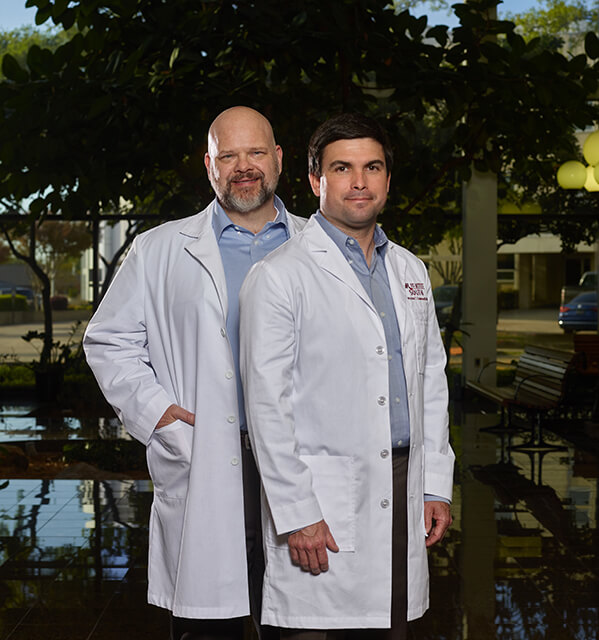At The Cataract Surgeons, a division of the WK Eye Institute, you’ll find skilled ophthalmic surgeons and experienced clinicians. Whether you require a routine eye exam or an advanced treatment for conditions such as keratoconus or macular degeneration, our dedicated team is here to provide exceptional care at our eye care centers around Shreveport, LA.
Explore our cutting-edge options for LASIK and cataract surgery at WK Eye Institute, where your vision health is our priority.
There is an easier way to pay for your vision care including LASIK. We’re pleased to accept the CareCredit credit card, North America’s leading patient healthcare financing program. CareCredit lets you begin your procedure immediately — then pay for it over time with monthly payments that fit easily into your monthly budget. Whether you’re considering LASIK, need cataract surgery, or it’s simply time for new glasses or contacts, CareCredit can help you see clearer, sooner.
We Offer the Following Treatments & Procedures:
Cataracts
Contact Fittings
Corneal Abrasions
Corneal Crosslinking
Diabetic Retinopathy
Dry Eye
Foreign Body Removal
General Eye Exam
Glasses Prescription
Glaucoma
Keratoconus (Only facility in the Ark-LA-Tex offering cutting-edge Cross-linking technology)
Intacs Corneal Implants
Laser Vision Correction (SMILE®, LASIK and PRK)
Macular Degeneration
Selective Laser Trabeculoplasty
Vitreolysis
Yag Laser Capsulotomy
The board-certified eye doctors at WK Eye Institute offer the best cataracts and LASIK services to patients in the Shreveport, LA area. Learn more or Call (318) 413-6855 today!
Schedule an eye exam or a surgery consultation with a provider!

.
Keratoconus
Intacs Corneal Implant
If you have keratoconus and are looking for ways to improve your symptoms, the Intacs corneal implant may be right for you. Our knowledgeable and experienced eye doctors at Willis Knighton Eye Institute use the most advanced technology to help you see better.
What is Keratoconus?
Keratoconus is an eye condition that affects the shape of your cornea. The cornea is the clear dome-shaped window at the front of your eye.
Keratoconus is characterized by progressive thinning and changes in the shape of the cornea. Keratoconus causes the cornea to bulge, taking a cone-like shape.
A normal cornea is much flatter, with a smooth spherical shape. The cone-shaped cornea of keratoconus causes the light entering your eye to be out of focus, resulting in blurred vision.
Keratoconus also causes thinning of the cornea, which makes them very delicate. The thinnest part of the cornea is located at the peak of the bulge in the cornea.
Keratoconus can also cause distorted vision, making everyday tasks like driving difficult. Some people with keratoconus wear contact lenses to help reshape their cornea, allowing them to see better.
However, in some advanced cases, contact lenses no longer work to improve vision. Eye doctors are unsure why some people develop keratoconus, although there is some evidence that it could be genetic.
Most people develop the condition in their late teens to early twenties. Blurred or distorted vision, increased sensitivity to light, and redness of the eyes are often the first symptoms shown in those with keratoconus.
What Are the Treatment Options for Keratoconus?
The treatment route your eye doctor chooses depends on the severity of the condition and your symptoms. In advanced cases of the condition, many eye doctors will recommend a corneal transplant as the best option for treatment.
Another option for the treatment of keratoconus is corneal crosslinking. During corneal crosslinking, your eye doctor uses UV light and eye drops to help make the cornea stronger.
Strengthening the cornea will make it flatter and keep it from developing more of a cone shape. The corneal crosslinking treatment can take up to one hour to complete.
Many eye doctors also use the Intacs corneal implant to treat keratoconus. While flattening your cornea and reducing keratoconus symptoms, Intacs can also improve your vision.
How Do Intacs Work?
Intacs are small implants made from medical-grade plastic that your eye doctor places behind the surface of your cornea. Using their unique design, Intacs work by changing the shape of your cornea.
Reshaping the cornea makes it a more natural dome-like shape and improves your vision. Our eye doctors at Willis Knighton Eye Institute are the only providers in the Ark-La-Tex region offering this advanced technology.
Not only can Intacs improve the structural issues of a cornea with keratoconus, but they can also provide you with improved vision. By reshaping the cornea to a normal dome-like shape, the light can focus correctly.
Once the light is focused correctly, you will see better. Intacs are a permanent solution to the associated symptoms of keratoconus.
Intacs corneal implants are an alternative to corneal transplants in those with severe cases of the condition.
Will Intacs Cure My Keratoconus?
The Intacs corneal implant is a treatment option for the symptoms of keratoconus, but it will not cure the condition. The implant will help normalize the shape and structure of your cornea.
The Intacs corneal implant may also reduce, delay or prevent the need for corneal transplant in some cases. The implant can also improve the shape of your cornea so that contact lens wear is possible.
Are Intacs Removable?
The Intacs corneal implant is placed in the inner surface of your cornea inside your eye and is permanent. The implant is not removable like a contact lens.
If there is a need for your eye doctor to remove your Intacs implant at any point in the future, it can be removed safely through another short procedure.
Who is a Candidate for Intacs?
If you are considering Intacs, your first step to determining if you would be a candidate for the procedure is to visit your eye doctor for an exam. During this visit, your eye doctor will perform a series of tests and measurements of your eyes.
These tests will help your eye doctor determine if the Intacs corneal implant would help improve your vision. Intacs will only work to correct blurred vision in nearsighted people.
Most people who receive Intacs are generally in good health and have mild to moderate keratoconus. Those with keratoconus whose vision is no longer adequately corrected using glasses or contact lenses may be a good candidate for Intacs.
Intacs will only improve vision affected by keratoconus and will not improve vision damaged by other eye conditions.
What Are the Benefits of the Intacs Procedure?
Besides improved vision, there are many advantages to choosing the Intacs corneal implant. One benefit of the implant is that no corneal tissue needs to be removed or replaced during the procedure, as it does in a corneal transplant.
Another benefit is that the implant reshapes and supports your cornea, providing structure to a weakened cornea. The Intacs corneal implant procedure is also quick and requires less recovery time than a corneal transplant.
What Is the Implant Procedure Like for Intacs?
The procedure to implant the Intacs is reasonably quick and usually is accomplished in about twenty minutes per eye. First, your eye doctor will give you an eye drop that numbs your eye.
Next, your eye doctor will make a single, small incision in your cornea. Next, they will place the Intacs below the surface of your cornea and position it in the correct location.
Lastly, the small opening in the cornea is closed. After this, the procedure is complete, and you are free to go home the same day.
What is the Recovery Like After Getting Intacs?
You must rest after the procedure and allow your eye time to heal and adjust to the new implant. Many people choose to take a few days off from work after the procedure to promote healing.
Many people will see results of vision improvement within a few days after the procedure. You will need to return to see your eye doctor a few times after the procedure.
Your eye doctor can ensure that your cornea is healing correctly at these visits. In some cases, you may still need the assistance of glasses or contact lenses after having the Intacs corneal implant.
Are you interested in learning more about your keratoconus treatment options like Intacs? Schedule an appointment at Willis Knighton Eye Institute in Shreveport, LA, today!



